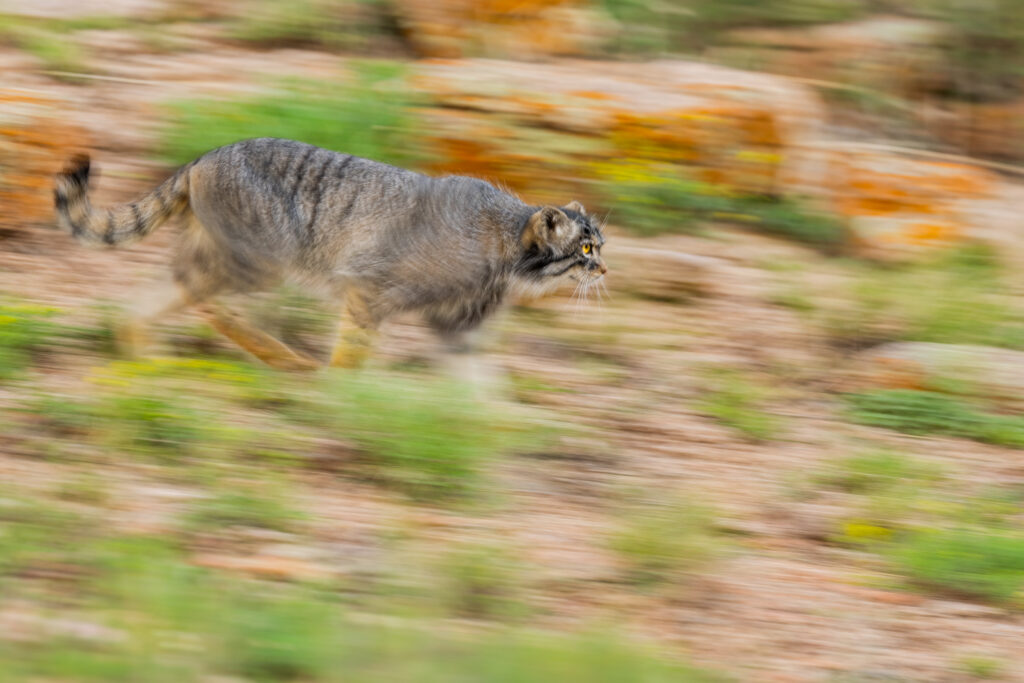This was the second of our three annual manul photo tours, where we visited eastern Mongolia. We are highlighting the events of our second tour, spending time with two different Pallas’s cat families, including a mother we named Nutella, and another we named Marmite. Read the rest of our second manul of Mongolia photo tour 2025 trip report to hear about all the details.
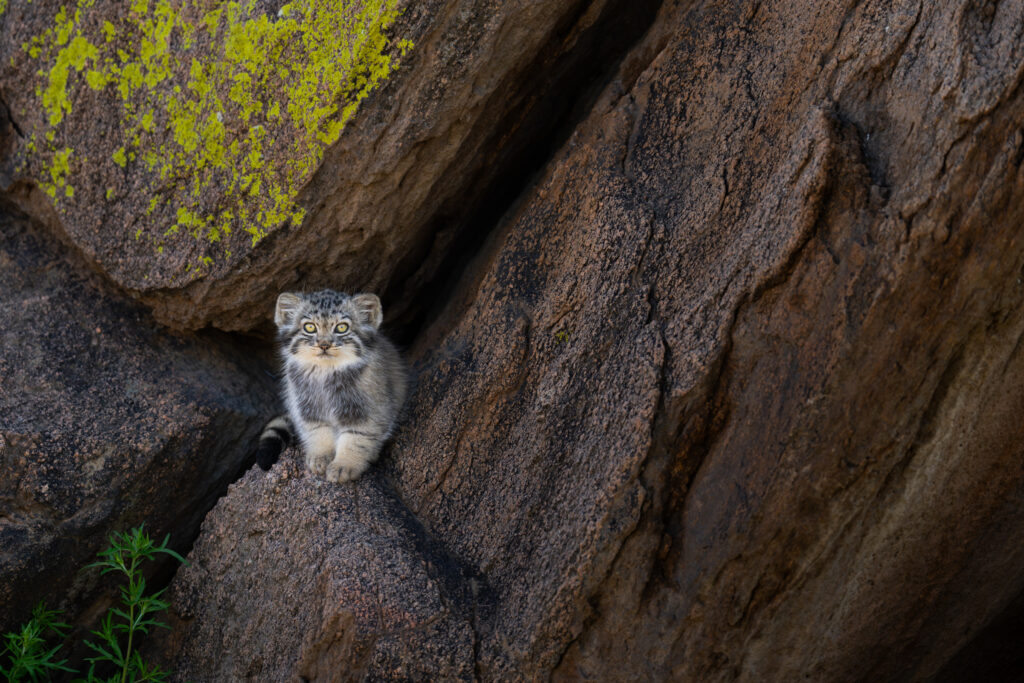
Highlights of the second 2025 Manul of Mongolia Photo Tour
Manul: We saw two different families of manul, one with three kittens, the other with four kittens that were slightly older. We split our time with Nutella (read our first trip report to learn more about her), and with a new female, we named Marmite, who’s four kittens were around seven weeks old. Our closest sighting was at eighteen meters, and on average the cats were about twenty three meters away from us. We saw manul on all days we spent in the field.
Manul Hunting: We watched Nutella be a hunting machine. We honestly think that manul have a higher success rate of hunts than even black-footed cats (which as of now keep getting the credit of being the deadliest cat). We saw one songbird being hunted succesfully, as well as six voles, all of which Nutella brought back to the den.
Other Wildlife: We had some fantastic opportunities with other wildlife this trip, including observing Eurasian eagle-owls and their fledglings, watched a saker falcon mob a steppe eagle, saw twelve steppe eagles around a carcass, and even had a steppe eagle attempt to hunt a corsac fox.
Detailed second Manul of Mongolia Trip Summary 2025
Day 1: We kicked things off in classic fashion — with a warm, laughter-filled welcome dinner. This time, we had an all-female group, which brought such a fun and powerful energy right from the start! Everyone had traveled from far and wide — Alaska, Canada, North Carolina, West Virginia — and the excitement in the room was unmistakable.
Over delicious food and easy conversation, we started to get to know each other, swapping stories and building that first layer of community. After dinner, with our hearts full and our alarms set early, we headed to bed — eager and buzzing for tomorrow’s journey out to the eastern steppes of Mongolia.
Day 2: We rolled out of Ulaanbaatar bright and early at 6am, beating the capital’s morning rush and hitting the open road. At our lunch stop, we dove into the week ahead with our welcome presentation — going over our goals, how we’d photograph manuls, and the rhythm of life in this wild and special place.
Not long after, Mongolia served up its first surprise: seven Cinereous Vultures gathered around a roadside carcass — an intense and fascinating sight, their massive wings and hunched postures right out of a nature documentary.
Once we arrived at camp, we settled in, got our gear organized, and set off on our first outing. It was too late in the day to responsibly search for manuls (there’s a process and we’re serious about respecting these wild cats), so instead, we went looking for Eurasian Eagle-Owls.
And wow — it didn’t take long. Perched in their rocky cliffside home was a pair of adults with two large fledglings, perfectly camouflaged against the stone. If it weren’t for their blazing orange eyes, you’d never even know they were there. We spent time photographing them in the golden light, marveling at how seamlessly they blend into the landscape.
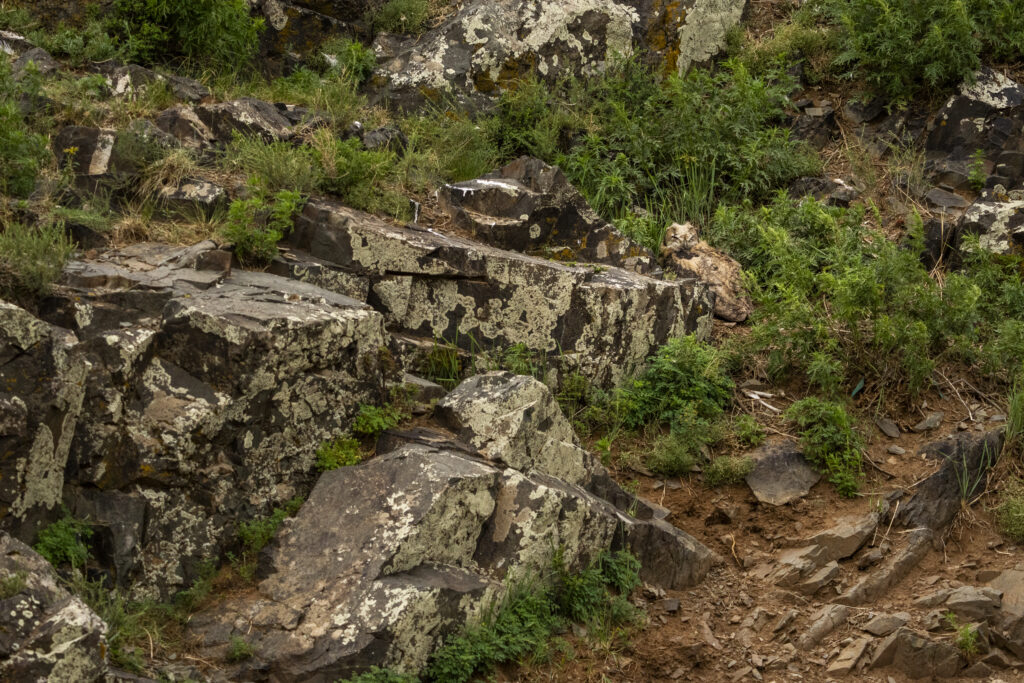
As a thunderstorm rolled in across the steppe, we packed up and headed back to camp — rain tapping the roof, dinner waiting, and a sense that this was just the beginning of something truly special.
Day 3: At 3:30am, the alarms jolted us awake — and so did the sound of light rain tapping on the canvas of our gers. We all lay there for a moment, wondering if our first morning session would be a wash. But just as we piled into the cars, rain jackets ready, the skies cleared. Mongolia was giving us a window — and we were ready to make the most of it.
We headed straight to the den of our favorite female manul, Nutella (if you’ve read our Tour 1 trip report, you’ll remember her well!). Spirits were high, and within minutes of settling in, there she was — peeking over the rocks with those unmistakable eyes, as if to say, “Where have you all been?”
It was a joy to see her again. True to form, she gave us a few minutes of that classic manul peek-a-boo behavior before stepping fully out onto the rocks. Then, to our delight, her kittens joined her. The moment was short — maybe five magical minutes — but it was enough to fill us with awe.
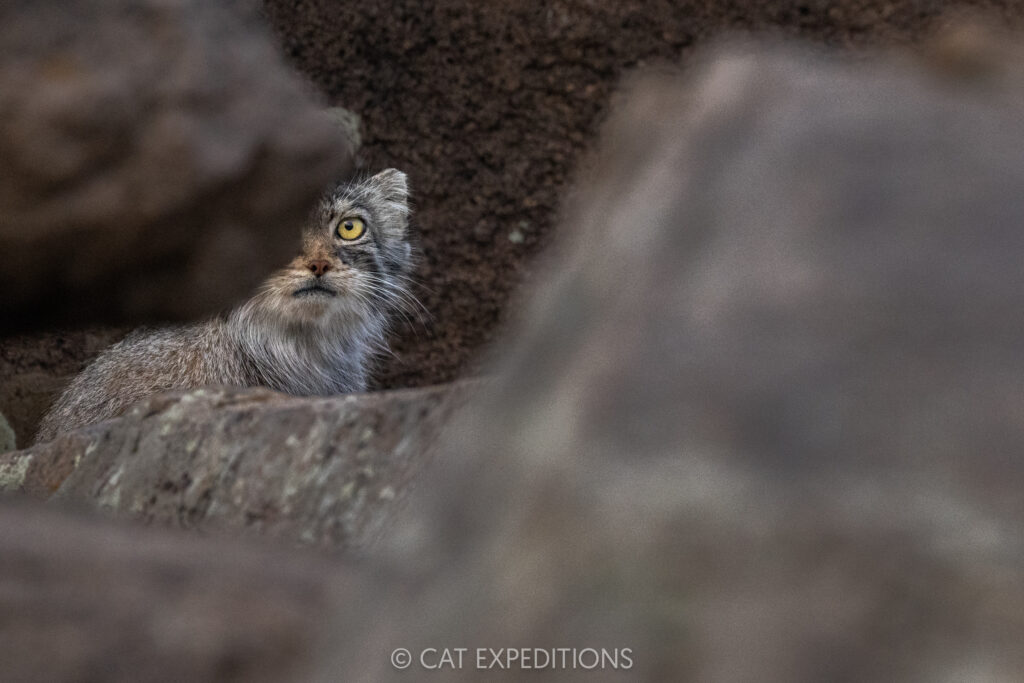
Then, just like that, she disappeared behind a cluster of boulders out of our line of sight. Our distant spotters later confirmed what we suspected: she had moved the kittens back to the den where we first met her.
Manuls are known to shift dens, especially after rain, often seeking higher, drier ground. With the light growing harsh, we made the decision not to follow — a move made in not wanting to risk disturbing her or the kittens.
We wrapped up the morning trying our luck with some Corsac foxes. True to character, they were skittish and elusive — but always fun to try for. Even with brief sightings, it was a morning full of beauty, intention, and a welcome reunion with an old friend.
In the late afternoon, we headed back out to see Nutella, now settled into her new den. The sun was strong on our backs as we tucked into the temporary blind, hopeful and quietly buzzing from the morning’s brief encounter. For the first thirty minutes, it was just us, the chirping of birds, and the sharp, clicking sounds of flying grasshoppers — no sign of the cats.
Then, finally, a tiny head appeared — cautious and wide-eyed, doing the classic shy manul scan. Moments later, another, and then a third. One by one, all three kittens emerged, their hesitation quickly melting into playful chaos. They wrestled, pounced, and tumbled over each other, sharpening their hunting skills on the best targets around: themselves.
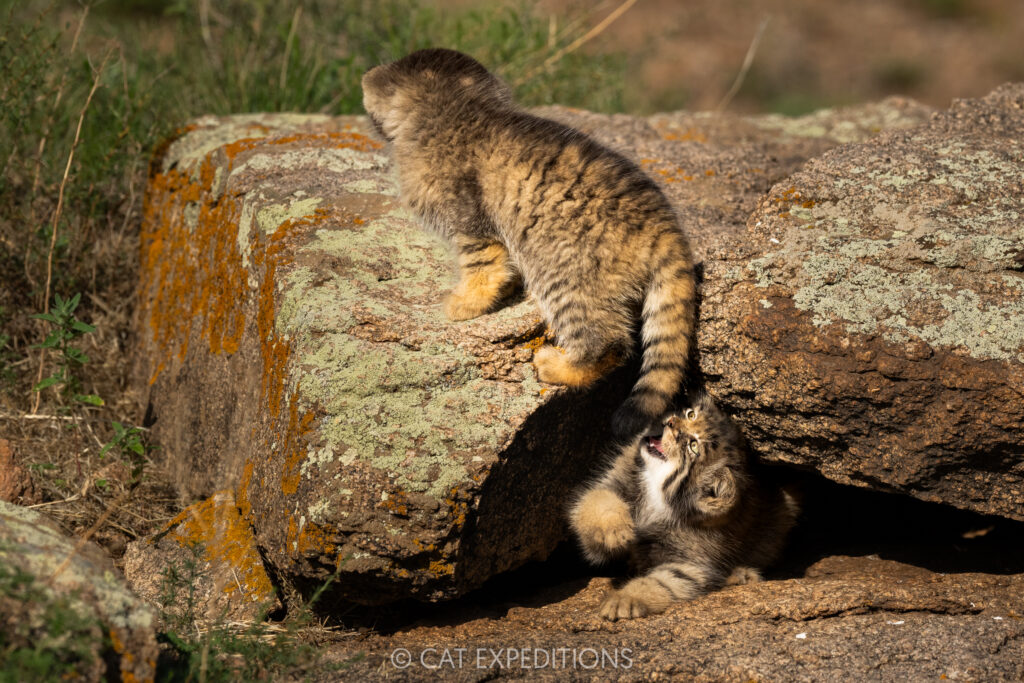
For the next three hours, we had front-row seats to their wild play. Nutella came and went, always with purpose, slipping away on hunting missions and returning like clockwork. And what a hunter she is — truly remarkable. In less than ten minutes, she caught a songbird and two Brandt’s voles, delivering them with calm precision to her rambunctious trio. The kittens, half-grateful and half-distracted, treated their meals like playthings — flinging them around, batting them with tiny paws, and occasionally remembering to take a bite.
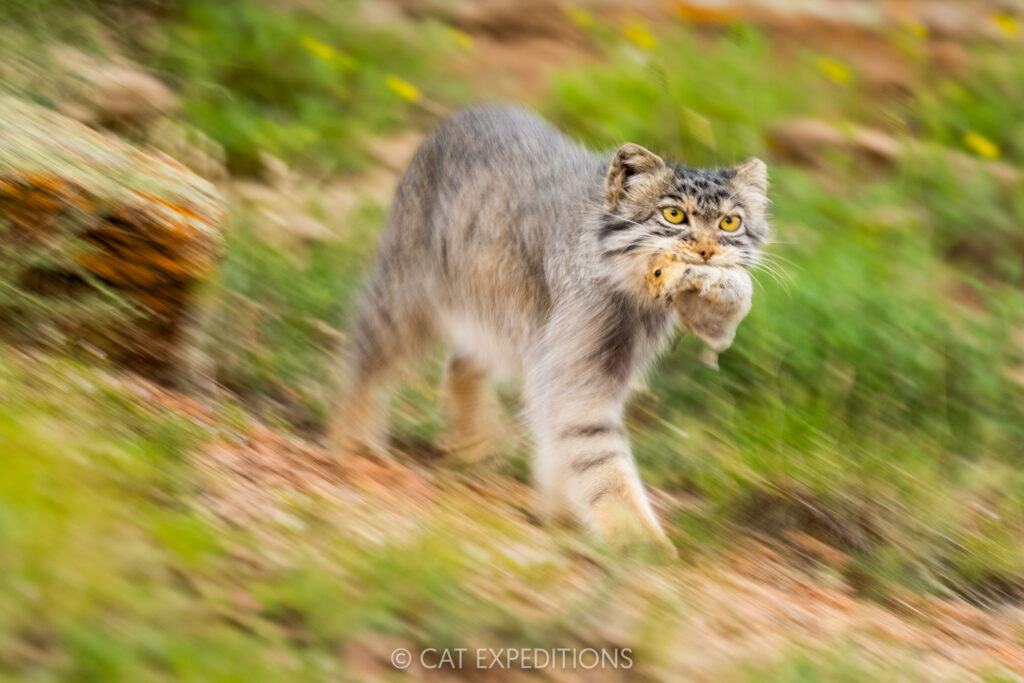
In total, Nutella caught six voles and one sparrow during our time with her — a masterclass in survival. And while the kittens may not have finished every meal, every pounce, swipe, and playful tumble was a step toward becoming hunters themselves.
It was an afternoon that can only be described as magical. Truly unbelievable. Among the group, we estimated around 70,000 photos were taken — a testament to just how much there was to capture. On the drive back to camp, we were glowing. These kinds of sessions don’t come often, and we knew how rare, how intimate, and how lucky we were to witness such a vibrant piece of wild life unfold before us.
Day 4: We were back to our usual 4am departure, eager to reconnect with Nutella and her kittens. As the sky slowly lightened, we found them right where we had left them the evening before. We slipped into the blind quietly, and not long after, Nutella emerged from the den and padded gracefully up the valley floor.
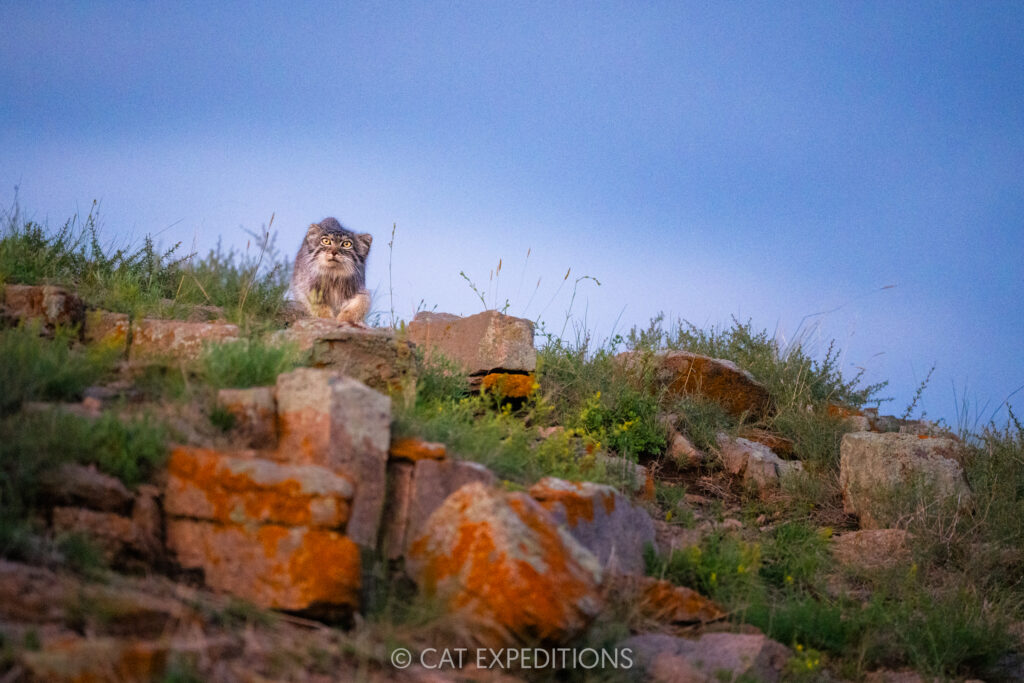
Then — a surprise. About forty yards away, two of her kittens came bounding up to greet her. Had they spent the night in a separate den from their mother? At just five weeks old, that would be an impressive step toward independence. But then came the next question: where was the third kitten?
Five minutes later, we got our answer — the missing sibling groggily appeared from the den Nutella had just left, blinking sleepily in the morning light. After a bit of stretching, she perked up and began practicing her stalking skills on nearby birds, still too drowsy to be effective. Nutella, meanwhile, had vanished into the valley, likely off on a hunting foray — not unusual. But as the hours passed and neither she nor the other two kittens reappeared, our concern began to grow.
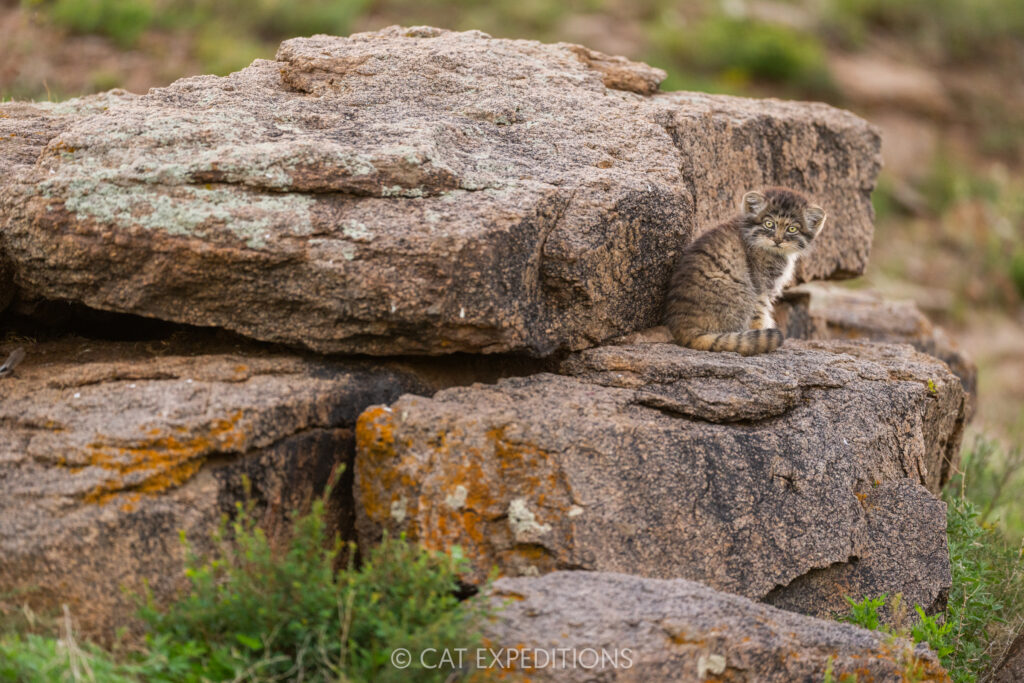
Why wasn’t the third kitten heading toward the back of the canyon, where her siblings likely were? From our angle, we couldn’t see beyond the boulders blocking the view, and the uncertainty tugged at all of us. After a while, we made the difficult decision to end the session early, giving the lone kitten as much space as possible — hoping she’d feel comfortable enough to leave and reunite with her family. But we couldn’t shake the worry. Were they really separated?
To minimize any disturbance, we decided not to return to the same den that evening. Instead, we shifted our focus to another manul family farther away. One of the biologists kept an eye on the Nutella situation from a distance with a spotting scope. He seemed far less concerned than we were — apparently, temporary separation is not uncommon. Still, in five years of watching manuls, we’d never seen it.
That evening’s den was breathtaking — a hidden pocket of grass and stone, nestled in a lush, boulder-strewn mini canyon. The den entrance was barely a slit in the rock — it never stops amazing us how these cats fold themselves into such tight spaces.
After a few hours of patient waiting, the mother emerged, moving with purpose toward her hunting grounds. About twenty minutes later, her kittens began to peek out — just the tops of their heads at first, wide-eyed and alert. Then the birds started arriving: rock sparrows, one after another. First ten, then twenty, then thirty — a noisy, fluttering crowd that caught the kittens’ full attention.
The kittens began to chatter — that familiar, hilarious, domestic-cat-like clicking sound — captivated by the birds just out of reach. But despite their interest, none of them dared a hunting attempt. They sat watching, practicing patience.
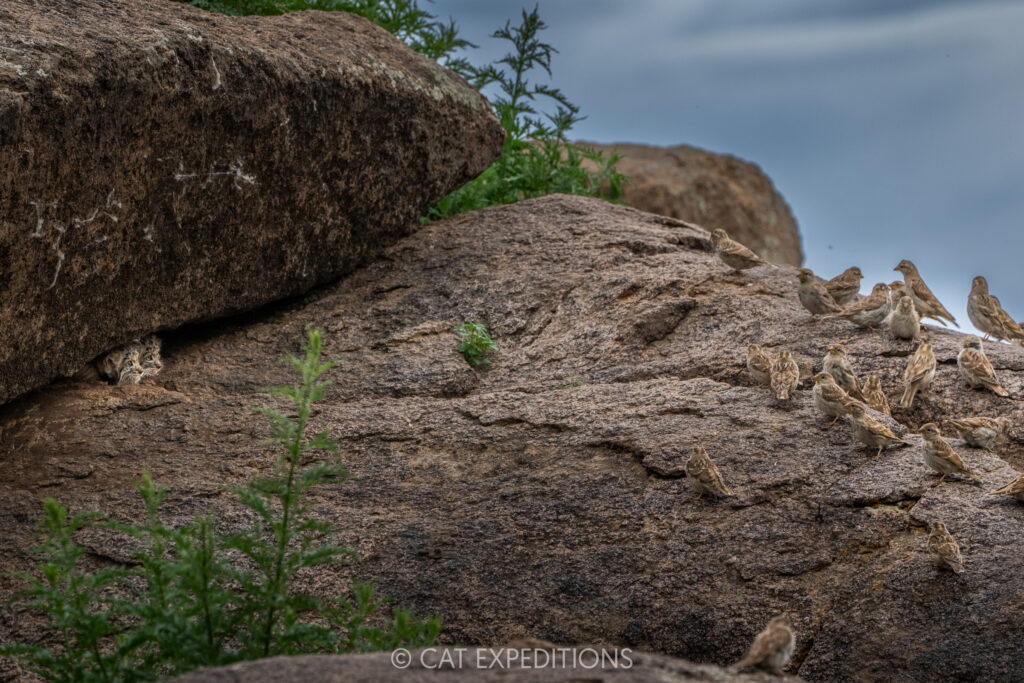
As sunset faded into dusk, the kittens finally emerged fully, mostly lounging near the den entrance, waiting for mom, who we later named Marmite, to return. One playful little one entertained us by batting around a tuft of sheep wool stuck to the rock — probably the cutest moment of the day.
As night settled in and we lost the last light for photography, mom returned, and we quietly packed up and made our way back to camp. Waiting for us was the best news we could’ve hoped for — Nutella had returned to the morning den and picked up the third kitten, reuniting the family.
Relieved and deeply content, we all fell into bed — tired, grateful, and ready for whatever tomorrow would bring.
Day 5: After such a magical afternoon with the newly discovered manul family, there was no question — we had to return to the same den. When we arrived, we saw they had shifted just slightly, now tucked into a neighboring rock formation just a few yards from the previous spot. The new den setup made our blind placement a little trickier — there was only a narrow view through which we could observe, but we made it work.
About thirty minutes after sunrise, the first kitten began to emerge, peeking out with that perfect mix of boldness and curiosity. It’s always fascinating watching how manul kittens evolve — just a week can make such a difference. At four weeks, they look at the blind with wary skepticism. By five weeks, you can almost see the curiosity creeping in: “What is that strange object over there, and should I pounce on it?”
A couple of songbirds landed nearby, and the kittens locked in immediately, their instincts kicking in. Their stalking attempts, if you could call them that, were more adorable than effective — full of wobbly, twitchy pounces and tail twitches that had us grinning from ear to ear.
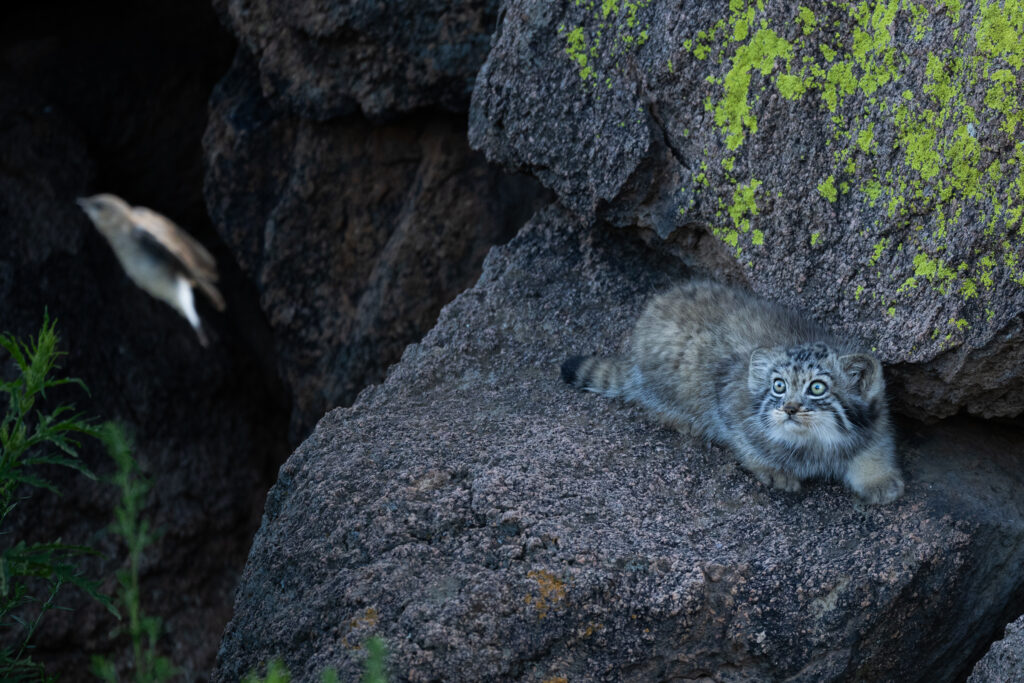
Not long after, kittens two, three, and four popped out to join the fun. And when you have a rock ledge full of manul kittens, there’s really only one thing that’s going to happen: playtime. For the next two and a half hours, we watched pure, unfiltered joy — chasing, tumbling, pouncing, and plenty of sneak attacks.
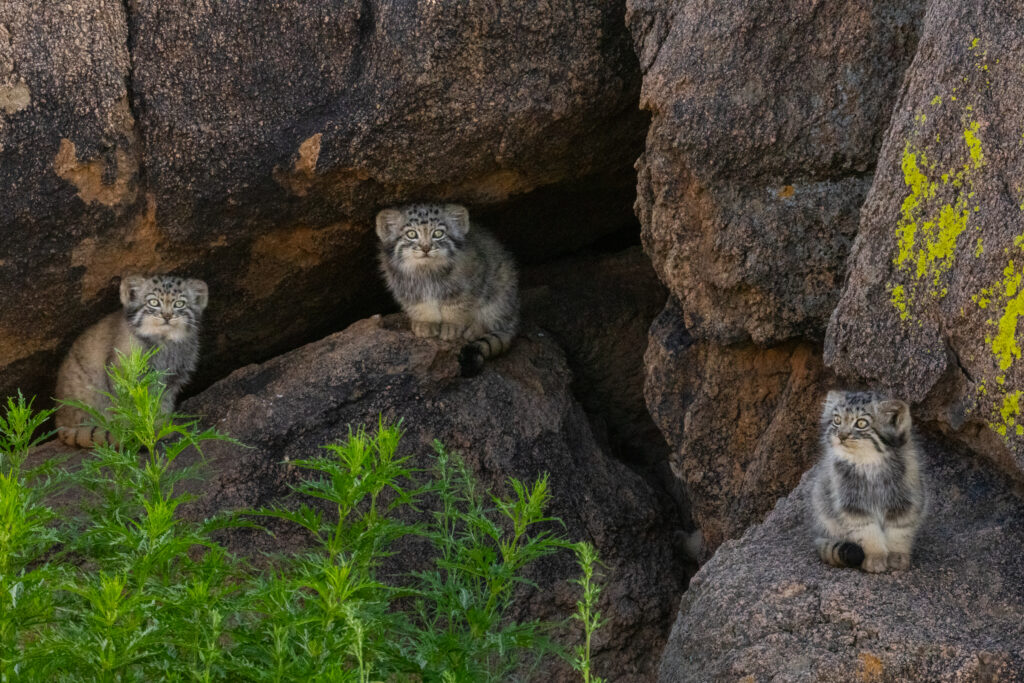
Our favorite moment? One little fluffball decided that its own tail was the best possible toy. It pawed at it, with its oversized mittens, completely absorbed in the game. From the blind came muffled, love-filled chuckles — the kind you try not to let out too loud, so you don’t break the moment.
These are the sessions we work for. As tour leaders, there’s nothing better than watching our guests fall in love with these cats — not just for the thrill of the sighting, but because every image they make, every story they tell afterward, becomes a tiny act of conservation. And it all starts with moments like this: four kittens, one tail, and a whole lot of heart.
We headed back out in the afternoon, excited to check in on Nutella and her kittens. This time, we decided to change things up — we repositioned the blind to get a new, lower angle, hoping for a fresh perspective and some creatively composed images. Of course, as soon as we settled in, a sudden rainstorm rolled through and sent us scrambling out of the blind. Classic steppe weather!
Thankfully, the skies cleared just as quickly as they had darkened, and we were able to get back into position. We waited quietly, the damp air still hanging heavy around us. About an hour later, little manul heads began to pop out — one, then another, then all of them. The kittens were back!
And then, there she was: Nutella, squeezing her way out of the den — no small feat, considering this particular den is really more of a tight crevice than a proper cave. She looked a little more cautious than usual, something we’ve noticed tends to happen after heavy rains. But after a few moments of surveying the area, she curled up right in front of the den entrance and started to doze off — a clear sign she felt safe and at ease.
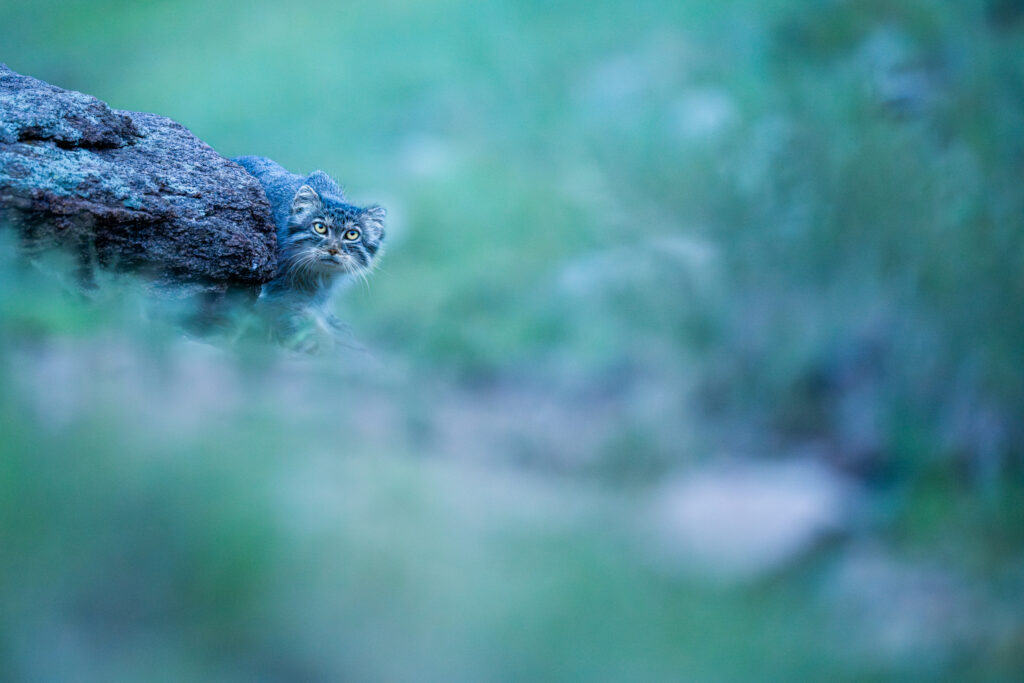
From our new angle, we mostly only saw the tops of the kittens, waiting patiently, or rather impatiently for the kittens to climb higher up onto the rocks. Eventually, our patience paid off: the little furballs clambered up onto the tallest rock, turning it into their personal playground. And then — Nutella joined them.
To our amazement, she lay down on the rock and began to nurse her kittens, right there in front of us. These are the moments that feel absolutely sacred.
Watching a nursing session in the wild is something incredibly special. The kittens eagerly shoved their tiny heads under her belly, reaching and pushing with determination to find her teats. Nutella ended up in a hilariously awkward pose — hunched over, almost on her tiptoes — as her little ones latched on. It only lasted a few minutes, but it was a window into the deep intimacy and tenderness of their wild lives.
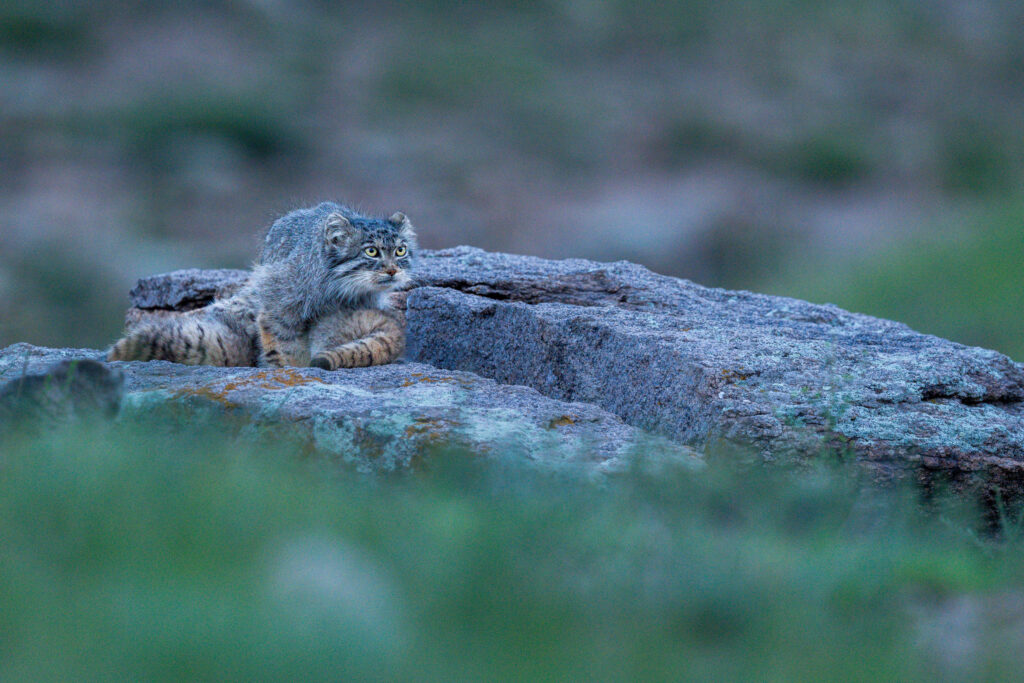
It’s hard to put into words what it feels like to witness behavior like this. As photographers and conservationists, we live for these rare, fleeting glimpses of raw nature. And each time we’re granted that privilege, we’re reminded of how lucky we are to be part of this story — even just as quiet observers, camera in hand, hearts full of affection for these cats.
Day 6: Switching back and forth between Nutella and Marmite meant this morning was Marmite’s turn again. We returned to her den, which was nestled in such a spot that we had to set up our blind across a small valley to get the best view. It made for a slightly more downhill perspective, but we crossed our fingers and hoped the action would come to us.
It didn’t take long.
The kittens started emerging almost right away, and it was immediately clear they had a serious case of the zoomies. They were absolutely bursting with curiosity and energy—clambering over every rock, leaping from ledges, and scaling crags that looked way too steep and tall for such tiny bodies. But they handled it all like pros. At one point, they even ventured out into the tall grasses surrounding the den—a real milestone in their development. They won’t leave mom’s side for another couple of months, but this felt like a small, bold step toward independence.

For two full hours we watched in awe as they ran, pounced, climbed, and wrestled. It was a non-stop show of wild joy and discovery. Marmite herself never appeared—she was likely off on a much-needed hunt—but we didn’t mind one bit. Getting to witness this kind of manul kitten behavior, these first explorations of the world beyond the den, is exactly the kind of moments we cherish to see.

Breaking from our usual rhythm—and still riding high from such a great morning session—we decided to head back to Marmite’s den for the afternoon. This time, we repositioned the blind, for a fresh angle and maybe a little photographic magic in the evening light.
Things started off slowly. A herd of cows wandered through just as we were getting settled, which always puts a damper on things. The cows didn’t linger too long, but their presence seemed to keep the manul family under cover for a while. We kept our eyes locked on the den, scanning for any movement, any flick of a tail or twitch of an ear.
Eventually, we began to catch a few fleeting glimpses—quick flashes of fur behind rocks, a paw here, a tail there—but still no clear views. It was one of those sessions where patience had to be our closest companion.
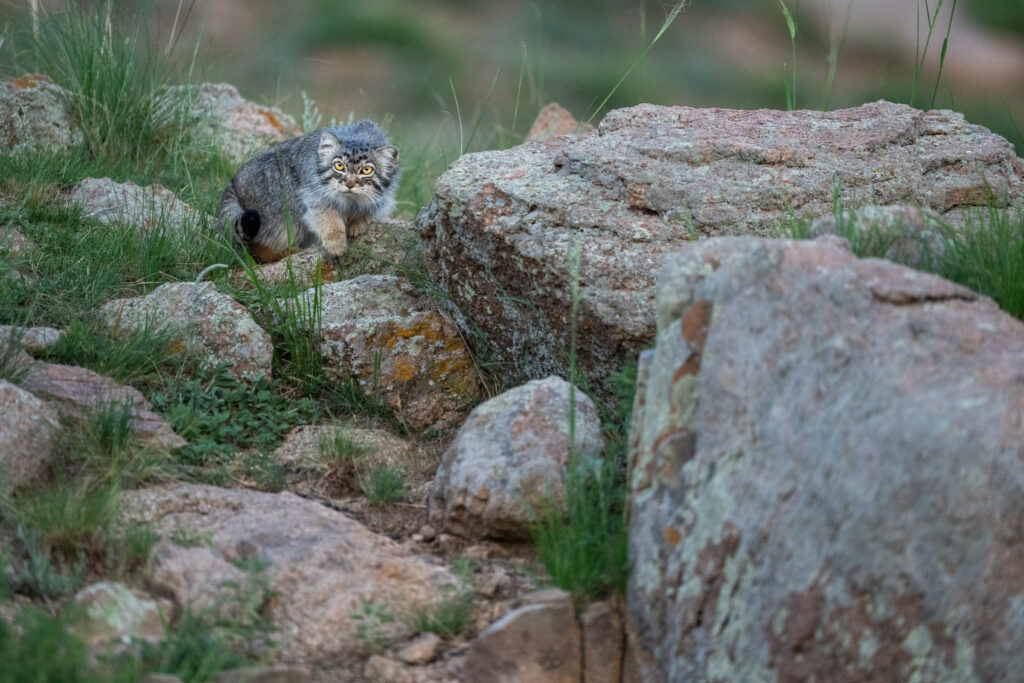
Then, out of nowhere, Marmite herself appeared. She cautiously climbed up out of the valley below, clearly still on edge with the cows nearby. It was a treat to see her—slow, deliberate, and incredibly alert. A moment later, one of her kittens came bounding up behind her, full of energy and completely unaware of mom’s caution. When it reached her, Marmite gave it a very clear “what are you doing up here?!” kind of look. And with that, the kitten did a quick 180 and bolted right back to the den. It was both hilarious and heartwarming.
Marmite eventually made her way back to the den, visibly uneasy as another group of cows began approaching from the other side. We caught a few more short-lived glimpses of the kittens, but they mostly stayed tucked away, sensing the mood wasn’t quite right.

Compared to our recent sessions, it was a quieter afternoon, but still meaningful. Not every encounter is action-packed—and that’s the beauty of working with wild animals. Sometimes, it’s about the subtle moments: a mother’s cautious gaze, a kitten’s misstep, the stillness between the action. These slower sessions help us appreciate just how much trust and balance exists out here—and how fragile it can be.
Day 7: After a night of steady rain, we weren’t too surprised to find Marmite’s den empty in the morning. It’s not unusual for manuls to move dens after a storm, seeking higher ground or better shelter. We searched for her for about twenty minutes, scanning the hills and valleys, but she had clearly relocated. So we shifted gears and headed out to look for Nutella.
Sure enough, Nutella had also moved overnight, but thankfully she was easier to find. Her new den was tucked into a rugged pile of rocks on a steep hillside—a tricky spot for setting up a hide, but we found a good vantage point from an adjoining hilltop. Before long, Nutella emerged and quickly made her way down into the distant valley to hunt. Her kittens, meanwhile, stayed tucked away inside the rocks, clearly unimpressed by the strong winds and the wait. Eventually, all three little heads poked out together, their tiny faces framed by stone—an absolutely adorable moment and definitely the highlight of the morning.
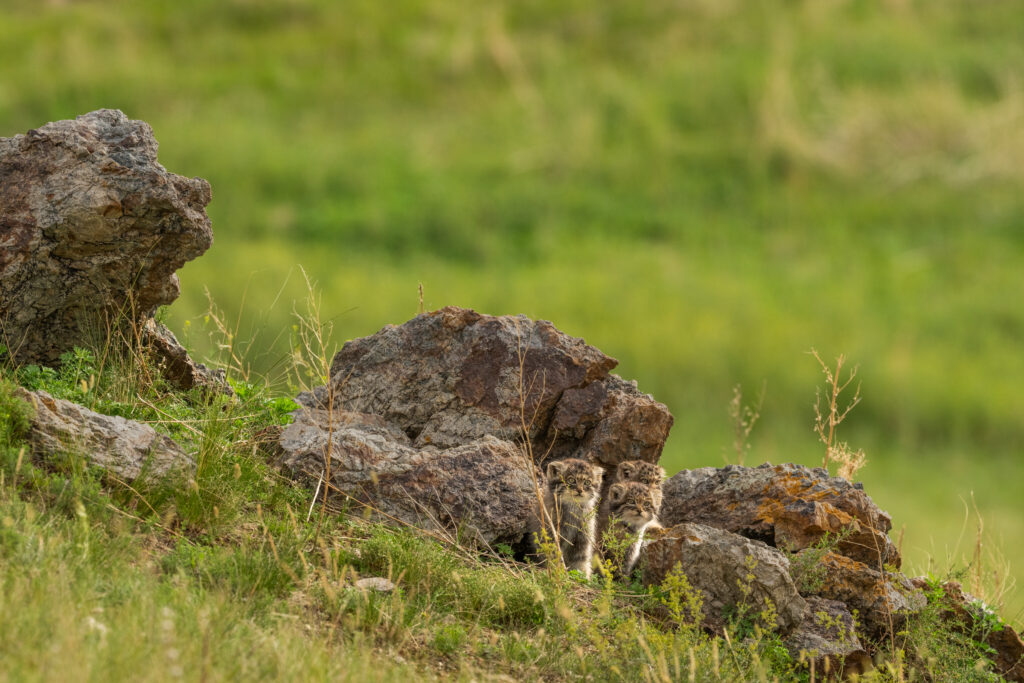
Before wrapping up the session, we stopped by Nutella’s old, now unoccupied den to give the group a closer look. It’s always mind-bending to see just how small these dens really are. This one was particularly shocking—so tight we couldn’t even fit a fist through the entrance. Just another reminder of how incredibly adaptable these cats are.
To finish off the morning, two guests set up at a nearby Corsac fox den and were rewarded with great photos as one of the foxes emerged and went about their business. A perfect little bonus.
Then came the afternoon—and with it, one of the worst storms we’ve experienced on the steppe. Rain didn’t fall so much as it poured in thick sheets, soaking everything in its path. A few of the gers started leaking, but nothing a few towels and buckets couldn’t handle. Fortunately, by the time we were ready to head back into the field, the storm had passed both camp and our target dens.
We returned to Marmite, thanks to the biologists who had tracked down her new location during lunch. The new den was on a lovely flat plateau, and we got into position with high hopes. But nature had other plans. A herd of cows wandered straight through the area, rubbing up against the rocks and grazing all around the den. One brave manul kitten poked its head out for a brief moment to see what the commotion was, but quickly ducked back in. The cows, surprisingly, seemed both startled and intrigued by the little feline peering at them. After about twenty minutes, they moved on—but the damage was done. The kittens stayed hidden for the rest of the session.
It wasn’t the finale we’d hoped for, but in a way, it was fitting. A reminder of the real, dynamic balance that exists out here. Livestock have been part of the steppe for thousands of years. They shape the landscape and affect the cats, though in ways that are subtle and mostly manageable.
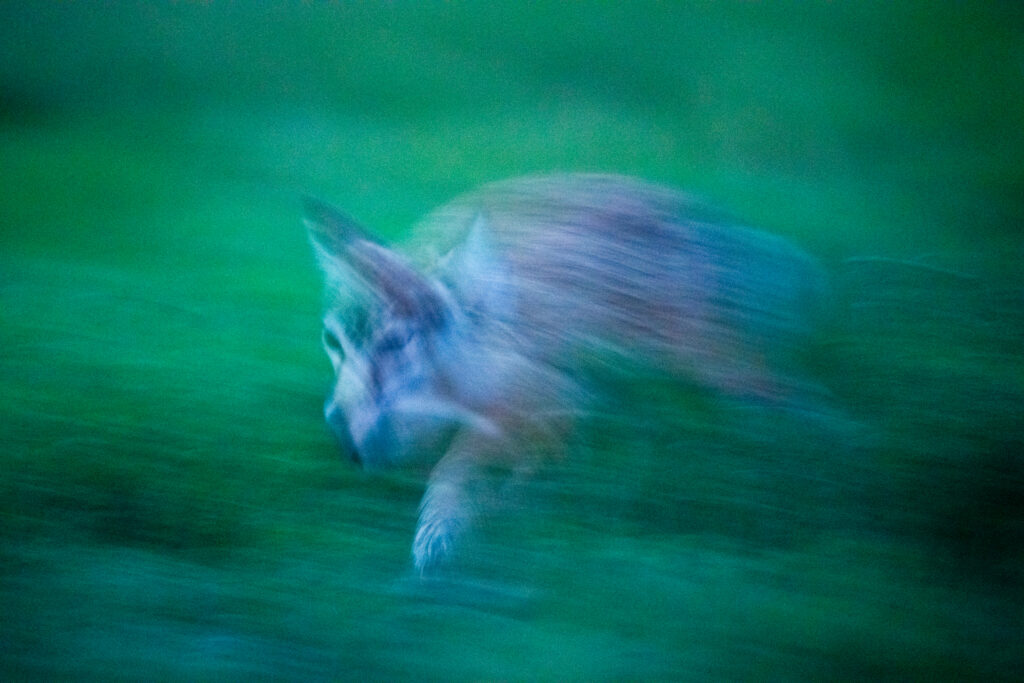
On the way back to camp, one of our vehicles had a final treat—an incredibly tolerant fox, casually foraging near the track. Instead of bolting, it actually walked toward the car, stopping just fifteen feet away. It was well after sunset, and our cameras struggled in the dim light—shutter speeds bottoming out at 1/13th of a second. But it didn’t matter. It was one of those magical encounters where the experience outweighed the photo. A perfect wild farewell to an unforgettable time on the steppe.
Day 8: With a glorious extra hour of sleep under our belts, we gathered for a relaxed breakfast, before beginning our journey back to Ulaanbaatar. Before we even hit the tarmac road, we were gifted one more sighting of an upland buzzard, a steppe eagle, and a flock of Mongolian gulls.
Thanks to all the recent rains, the once-dry steppe had transformed into a sprawling patchwork of wetlands, dotted with birds and bursts of green — a beautiful final impression of the landscape we’d come to love.
That evening, back in the city, we gathered for our final dinner together — a tradition filled with laughter, storytelling, and a healthy dose of reminiscing. But this one had a twist: one of our guests from the third manul tour had arrived early and joined us for dinner. Their arrival sparked an extra round of enthusiastic highlight sharing, with tales of kittens, foxes, and thunderstorm drama being relived with even more gusto.
We filled our bellies with delicious food we hadn’t tasted in over a week, and our hearts with the joy of connection — to the cats, to the land, and most importantly, to each other. What a way to end a trip.
Manul of Mongolia Photo Tour 2025 Species List – Trip 2
Mammals
| Manul | Otocolobus manul |
| Corsac Fox | Vulpes corsac |
| Mongolian Gerbil | Meriones unguiculatus |
| Brandt’s Vole | Lasiopodomys brandtiie |
Birds
| Ruddy Shelduck | Tadorna ferruginea |
| Common Shelduck | Tadorna tadorna |
| Demoiselle Crane | Anthropoides virgo |
| Cinereous Vulture | Aegypius monachus |
| Steppe Eagle | Aquila nipalensis |
| Black Kite | Milvas migrans |
| Upland Buzzard | Buteo hemilasius |
| Eurasian Eagle-Owl | Bubo bubo |
| Saker Falcon | Falco cherrug |
| Common Swift | Apus apus |
| Pacific Swift | Apus pacificus |
| Eurasian Hoopoe | Upupa epops |
| Daurian Jackdaw | Corvus dauuircus |
| Northern Wheatear | Oenanthe oenanthe |
| Isabelline Wheatear | Oenanthe isabellina |
| Horned Lark | Eremophila alpestris |
| Mongolian Lark | Melanocorypha mongolica |
| House Sparrow | Passer domesticus |
| Eurasian Tree Sparrow | Passer montanus |
| Rock Sparrow | Petronia petronia |
| Pere David’s Snow Finch | Montifringilla davidiana |
